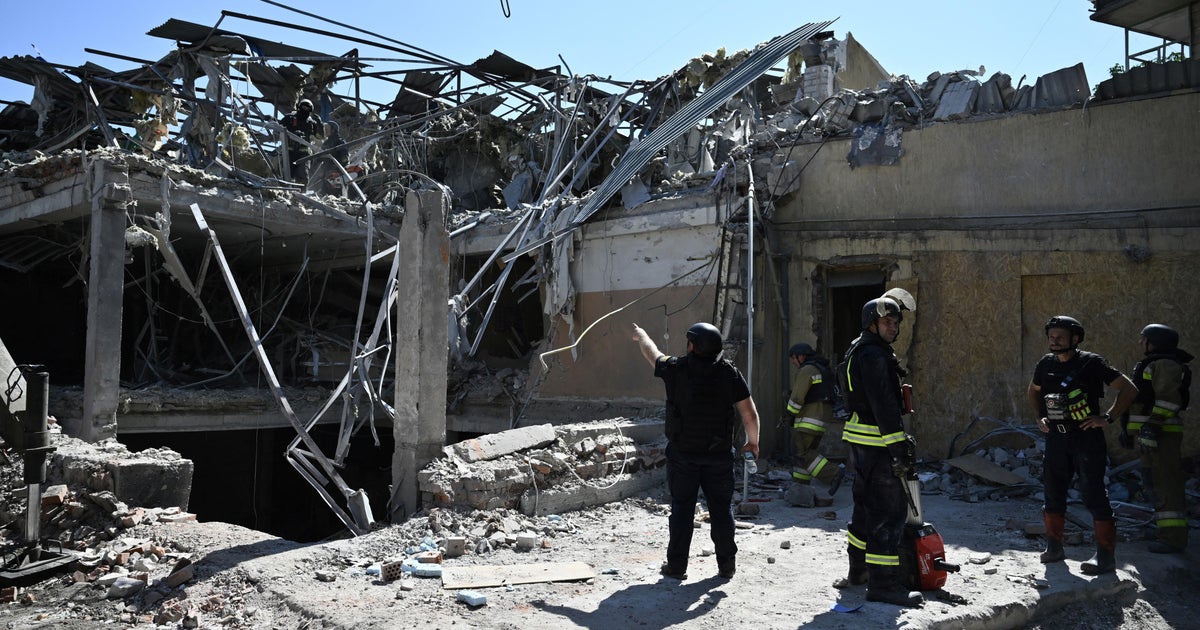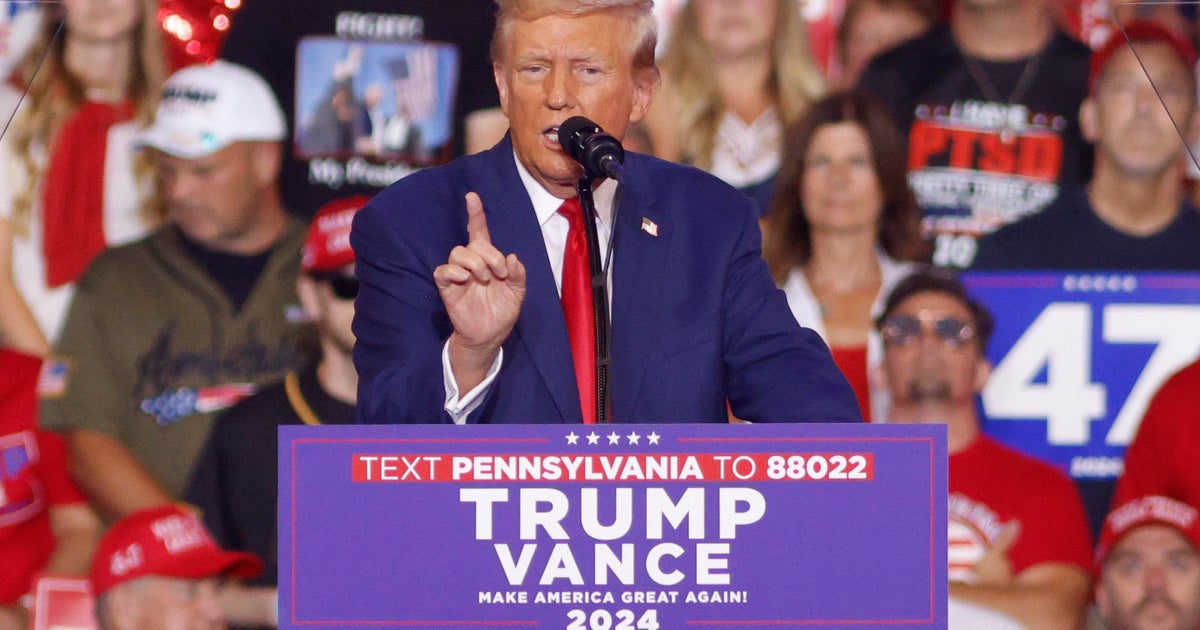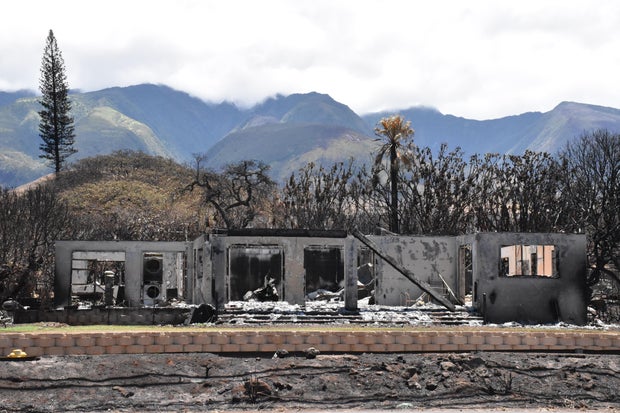CBS News
Russia hits Ukraine’s energy infrastructure with huge wave of drones and missiles, reportedly killing 3 people

Kyiv, Ukraine — Russia unleashed a massive drone and missile barrage across Ukraine on Monday targeting energy infrastructure, reportedly killing at least three people and hitting power facilities in at least three regions. Officials in the Zaporizhzhia, Rivne and Lviv regions said in messages posted on social media that energy infrastructure had come under attack. Officials in several other regions also reported strikes on power and other critical infrastructure sites.
The barrage began around midnight and continued beyond daybreak in what appeared to be Russia’s biggest attack on Ukraine in weeks.
“The energy infrastructure has once again become the target of Russian terrorists. Unfortunately, there is damage in a number of regions,” Ukraine’s Prime Minister Denys Shmyhal Shmyhal said, adding that Ukraine’s state-owned power grid operator, Ukrenergo, had been forced to implement emergency power cuts to stabilize the system.
He called on Ukraine’s allies to provide Kyiv with long-range weapons and permission to use them on targets inside Russia.
GENYA SAVILOV/AFP/Getty
“In order to stop the barbaric shelling of Ukrainian cities, it is necessary to destroy the place from which the Russian missiles are launched,” Shmyhal said. “We count on the support of our allies and will definitely make Russia pay.”
According to Ukraine’s air force, multiple groups of Russian drones flew toward eastern, northern, southern and central regions of the country, followed by multiple cruise and ballistic missiles. Explosions were heard in the capital, Kyiv, and power and water supplies in the city were disrupted by the attack, Kyiv Mayor Vitali Klitschko said.
In the wake of the barrage, the city administration announced plans to open “points of invincibility” — shelter-type places where people can charge their devices and get refreshments during energy blackouts. Such points were first opened in Ukraine in the fall of 2022, when Russia targeted the country’s energy infrastructure with weekly barrages.
Ihor Polishchuk, mayor of Ukraine’s western city of Lutsk, said a multistory residential building and an unspecified infrastructure object were hit and one person was killed. Another person was killed in the central Dnipropetrovsk region, where the attack sparked multiple fires, damaged a dozen households and completely destroyed two, regional head Serhii Lysak said. One person was rescued from under the rubble, Lysak said.
One person was also killed in the southeastern, partially occupied region of Zaporizhzhia, regional head Ivan Fedorov said. According to Fedorov, an infrastructure facility was hit and caught fire.
In the southern Mykolaiv region, three people were injured, regional head Vitalii Kim reported. He also urged local residents to use “points of invincibility” in the region.
In the outlying Kyiv region, one person was injured in an attack that hit unspecified infrastructure objects and residential houses, regional head Ruslan Kravchenko said.
Ukraine’s private energy company, DTEK, introduced emergency blackouts, saying in an online statement that “energy workers throughout the country work 24/7 to restore light in the homes of Ukrainians.”
In neighboring Poland, the military said Polish and NATO air defenses were activated in the eastern part of the country as a result of the attack.
In Russia, in the meantime, officials reported a Ukrainian drone attack overnight and on Monday morning.
Four people were injured in Russia’s central region of Saratov, where drones hit residential buildings in two cities. One drone crashed into a residential high-rise in the city of Saratov, and another hit a residential building in the city of Engels, home to a military airfield that had been attacked before, local officials said.
Russia’s Defense Ministry said that a total of 22 Ukrainian drones were intercepted overnight and in the morning over eight Russian regions, including the Saratov and Yaroslavl regions in central Russia.
CBS News
Report finds “no evidence” Hawaii officials prepared for deadly wildfire despite warnings

Investigators reviewing the emergency response to last year’s devastating wildfire on Maui said in a report released Friday they found “no evidence” Hawaii officials made preparations for it, despite days of warnings that critical fire weather was about to arrive.
That lack of planning and a misperception of the risk hindered efforts to evacuate the historic town of Lahaina before it burned, claiming 102 lives, the report said.
“While much of Hawaiʻi, including Maui, has a relatively high risk of wildfire occurrence, it appears the perception of this risk—at the local, state, and national levels—is not always aligned with the actual, growing threat wildfires pose to the population and built environment,” the report said. “This gap between risk perception and reality seems to have contributed to a relative underinvestment in wildfire prevention, preparedness, and response capacity over the years.“
A weather forecaster with the National Weather Service emailed fire managers an “unprecedented advance warning” on Aug. 4, 2023, of the danger that would develop on Aug. 8, including extreme winds as a hurricane passed far to the south, according to the report released by the state attorney general. The email stressed the unusual certainty of forecast models and “significant concern” on the part of forecasters.
Zeng Hui/Xinhua via Getty Images
But in the ensuing four days, the report found, there is no evidence that key agencies — the Hawaii Emergency Management Agency, Maui Fire Department, Maui Police and others — developed plans for dealing with severe wildfire risk, such as by having extra staff on duty, stationing emergency vehicles or supplies in high-risk areas, or plotting possible evacuations.
“The strongly worded nature of the email, had it been communicated to fire managers in other states with better developed severity preparedness strategies, could have gained attention and prompted discussion and operational planning,” the report said. “It was a call for State of Hawaii fire managers to prepare for the impending extreme weather.”
The heroic efforts of firefighters and police — who frequently risked their lives, sometimes sprinting door-to-door to warn residents to leave or piling evacuees into their cars to drive them to safety — were undercut by a lack of planning as the deadliest U.S. wildfire in a century destroyed thousands of buildings and caused billions in damages.
Neither Maui County nor the Hawaii Emergency Management Agency immediately responded to emails seeking comment.
“This investigation serves as a wake-up call for the state and county governments to learn from the past and urgently prepare for the future,” Attorney General Anne Lopez said in a statement accompanying the report.
Maui fire commanders discussed the forecast, but “no evidence of pre-event preparedness plans by the MFD were produced,” the report said. The police and fire departments never established a unified incident command post, and as a result it was more difficult to know who was responding to what, or where evacuation routes were blocked by downed trees or power lines.
The report recommends establishing “standard operating procedures for Red Flag and severe fire weather warning conditions, to include: preparing and pre-positioning supplies, equipment, vehicles, and personnel in high-risk areas; ensuring clear and open lines of communication within and among agencies to optimize for rapid and coordinated deployment of resources; and communicating with the public to aid residents in translating the forecasted conditions and risks into evacuation readiness.”
The departments share a mobile command vehicle, but the county did not provide evidence that it was used that day, the report said. Some emergency vehicles didn’t have equipment for clearing roadblocks like fallen trees or locked gates on private roads.
/ Getty Images
With multiple fires burning on Maui before the devastating blaze erupted in the afternoon, police focused on routine duties like traffic control rather than preparing for an evacuation, the report said. Responders lacked an incident action plan, which meant trouble figuring out where to direct resources. The police and fire departments operated separately, hindering communication as the winds toppled utility poles, cutting power and cell service.
And despite the warnings from forecasters, the heads of the county emergency management agency and the Maui Fire Department were both off-island that day, attending conferences in Honolulu. The report said no one appeared to be in charge of strategic resource allocation.
Some of the challenges facing officials and residents were particular to Hawaii and Maui: narrow roads clogged with parked cars and small, inconsistently named dirt roads often blocked by gates.
Many older, wooden homes were designed to resist heat and humidity, not wildfire. They were often separated by less than 6 feet (1.8 meters), and residents frequently left windows open, making it easier for the fire to spread.
Some people died in their cars. Others leaped into the ocean to escape the flames.
The 518-page report, conducted for the Hawaii attorney general’s office by the Fire Safety Research Institute, is the second part of a three-part attempt by officials to understand the tragedy and how best to avoid such disasters in the future.
The review determined that the lack of planning fit a long pattern of apathy to wildfire risk in Hawaii, where tsunamis and hurricanes are considered more pressing dangers, and it was among many factors that set the stage for the catastrophe. The report suggested that fire managers might have focused on the first sentence of the National Weather Service’s email, which noted Hurricane Dora was expected to pass south of the state, rather than make landfall, and thus assumed Hawaii was safe.
Even though a 2018 wildfire in West Maui near Lahaina burned 2,000 acres (810 hectares), destroyed 21 structures and forced 600 people into shelters, the Maui Police Department’s “Natural and Man-Made Disaster Plan” didn’t include wildfires.
The Maui Fire Department has policies for responding to hurricanes — a hurricane watch requires a staffing roster and rotational schedule for relief personnel, for example. But the department had no such policies for high fire danger, the report said.
And even though Maui County passed legislation in 2022 giving the fire department the authority to require property owners to clear vegetation, such as the dry invasive grasses that helped fuel the Aug. 8 fire, under penalty of a $1,000 fine, the county “has not produced any evidence that the MFD has enforced these amendments in the Lahaina area,” the report said.
The report urged Maui police, firefighters, the state land department and Maui emergency managers to work on their procedures and study and implement policies in place in other states.
For example, the report highlights that the “average number of Red Flag Warning days annually in Hawaiʻi is similar to some areas in California where emergency managers and local officials have initiated significant changes to their preparedness efforts over the course of the last 30 years.”
CBS News
FTX founder Sam Bankman-Fried appeals fraud conviction

Lawyers for Sam Bankman-Fried claim in an appeal filed Friday that the imprisoned FTX founder was the victim of a rush to judgment by a public that wrongly believed he was guilty of stealing billions of dollars from his customers and investors before he was even arrested.
The lawyers filed papers with the 2nd U.S. Circuit Court of Appeals asking a three-judge panel to reverse Bankman-Fried’s conviction and assign the case to a new judge for a retrial, saying the trial judge “imposed a draconian quarter-century sentence on this first-time, non-violent offender” after they contend he hurried the jury into reaching a one-day verdict to cap off a complex four-week trial.
“Sam Bankman-Fried was never presumed innocent. He was presumed guilty — before he was even charged. He was presumed guilty by the media. He was presumed guilty by the FTX debtor estate and its lawyers. He was presumed guilty by federal prosecutors eager for quick headlines. And he was presumed guilty by the judge who presided over his trial,” the lawyers wrote.
They said the passing of time has cast Bankman-Fried in a better light.
“From day one, the prevailing narrative — initially spun by the lawyers who took over FTX, quickly adopted by their contacts at the U.S. Attorney’s Office — was that Bankman-Fried had stolen billions of dollars of customer funds, driven FTX to insolvency, and caused billions in losses,” the attorney said.
“Now, nearly two years later, a very different picture is emerging — one confirming FTX was never insolvent, and in fact had assets worth billions to repay its customers. But the jury at Bankman-Fried’s trial never got to see that picture,” they added.
Bankman-Fried, 32, was convicted last November of fraud and conspiracy, a year after his companies collapsed into bankruptcy as investors rushed to withdraw funds. A jury concluded that some of their money had been improperly spent on real estate, investments, celebrity endorsements, political contributions and lavish lifestyles.
At its height, FTX was treated as a pioneer and darling in the emerging cryptocurrency industry, with a Super Bowl advertisement, testimony by Bankman-Fried before Congress and endorsements from celebrities such as quarterback Tom Brady and comedian Larry David.
Bankman-Fried was arrested in December 2022 following his extradition from the Bahamas, just weeks after his company filed for bankruptcy and days after some of his former top executives began cooperating with federal prosecutors. Some of them testified against him at trial.
He initially remained under strict bail conditions at his parents’ home in Palo Alto, California, but Judge Lewis A. Kaplan in Manhattan revoked his bail shortly before the trial after concluding that Bankman-Fried was trying to influence likely witnesses, including an ex-girlfriend who had served as chief executive at Alameda Research, a crypto hedge fund.
The fallen mogul is serving a 25-year sentence after he was sentenced in March in what a prosecutor once described as one of the biggest financial frauds in U.S. history.
A prosecutor’s spokesperson declined to comment Friday.
CBS News
Trump unveils “no tax on overtime pay” policy in Arizona remarks

Former president Donald Trump promised this week to eliminate income taxes on overtime pay if he wins a second term in November.
During remarks on the economy in Tucson, Arizona, Trump unveiled the policy which he said would give “people more of an incentive to work.”
“If you’re an overtime worker, when you’re past 40 hours a week, think of that, your overtime hours will be tax-free,” Trump said.
Any changes to the U.S. tax code require approval from Congress. In 2025, lawmakers will have an opportunity to rewrite the country’s tax laws, when Trump’s 2017 tax laws are set to expire. Trump’s new tax policies — which also include a proposal to end taxes on tips and a proposal that seniors should not pay taxes on social security benefits — are aimed primarily at hourly wage workers, a group that both presidential candidates are courting.
“The people who work overtime are among the hardest working citizens in our country and for too long, no one in Washington has been looking out for them,” Trump said. “They’re police officers, nurses, factory workers, construction workers, truck drivers and machine operators.”
The candidate’s latest tax-riddance proposal would cost $227 billion over 10 years, according to a conservative estimate calculated on Friday by the Tax Foundation, an independent tax policy research organization.
If enacted, the proposal could also spur a shift in those classified as salaried and exempt from overtime to those categorized as hourly workers, Garrett Watson, senior policy analyst at the Tax Foundation, told CBS News. “There are no guardrails on this, so the cost could go up from there,” Watson said.
Added together, Trump’s recent series of tax-exemption proposals “all add up to a multitrillion-dollar hole in deficit financing,” said Watson. “The big question is, to what extent does this make sense as a policy perspective,” he added.
“As an economist, I’m struggling to understand what the rationale is,” offered Janet Holtzblatt, a senior fellow at the Urban-Brookings Tax Policy Center.
Trump’s proposal raises ethical and administrative questions including, “Can the IRS handle this?” said Holzblatt, who previously worked as an analyst in the Congressional Budget Office, the U.S. Treasury and for the Senate Budget Committee.
“It has the possibility of unintended effects — by helping one group of people, you may be harming another group of people,” said Holzblatt, noting the potential impact of how the labor market, in terms of wages and salaries, gets restructured — it gives the employer an incentive to change the base rate, or regular pay.”
Both Hozblatt and Watson said additional details of what Trump’s proposal would entail are needed to have a better grasp of its potential impact.
Vice President Kamala Harris’ campaign calls Trump’s tax pitch is an attempt to “trick” Americans. It noted that the Trump administration in 2019 opted to cover far fewer workers in its overtime pay rule than had been proposed by the prior administration under former President Obama.
“Trump tried to rip away overtime pay for nearly 10 million workers and devastated families,” Joseph Costello, a spokesperson for the Harris campaign, said. “A second term will be even worse: Trump’s Project 2025 Agenda would allow employers to stop paying many workers overtime.”
The Harris campaign’s take was echoed by economist Heidi Shierholz, who leads the Economic Policy Institute, a left-leaning nonprofit think tank.
“Trump’s new playbook is to claim he won’t tax the earnings of the very groups of workers whose earnings he already has a clear record of undermining,” noted Shierholz, who was formerly chief economist at the Department of Labor.
Further, Trump’s proposal could wind up mostly benefiting the highest-paid Americans, according to Shierholz.
“To allow their salaried, overtime-exempt workers to get the tax cut, employers could easily switch them to hourly,” she noted. “It is not unreasonable to imagine that this policy would lead to a world where corporate CEOs earn $4,000 an hour plus $6 million in overtime.”










